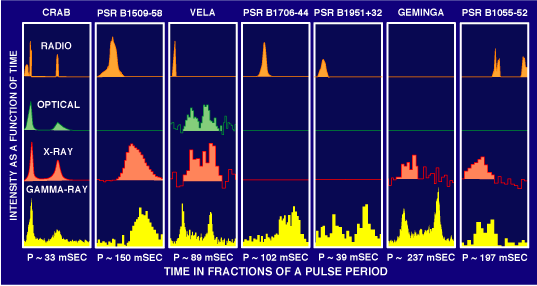Pulse shapes of seven well-known pulsars
(Credit: D.J. Thompson (NASA/GSFC)) Among the more than 1000 known pulsars, these seven are seen by gamma-ray telescopes and in some cases at other wavelengths. The pulse shapes (sometimes called "light curves" by pulsar astronomers) show the brightness of each pulsar as the neutron star makes one complete rotation. Here the pulse shapes as seen by radio, optical, X-ray, and gamma-ray telescopes are shown. The variety of pulse shapes is quite large, both from pulsar to pulsar and for individual pulsars seen by different telescopes. The Crab pulsar (far left) looks much the same to all telescopes. The Geminga pulsar (second from right) is only seen clearly in X-rays and gamma rays. The Vela pulsar (third from left) has a different pulse shape at each wavelength, and the pulses do not even arrive at the same time (although they all repeat with the same period, determined by the time it takes the neutron star to rotate). See more detail about the high energy profiles of these pulsars.
IMAGES |
By Mission |
Stars |
HEASARC Home | Observatories | Archive | Calibration | Software | Tools | Students/Teachers/Public Last modified: Thursday, 26-Jun-2003 13:48:45 EDT |


